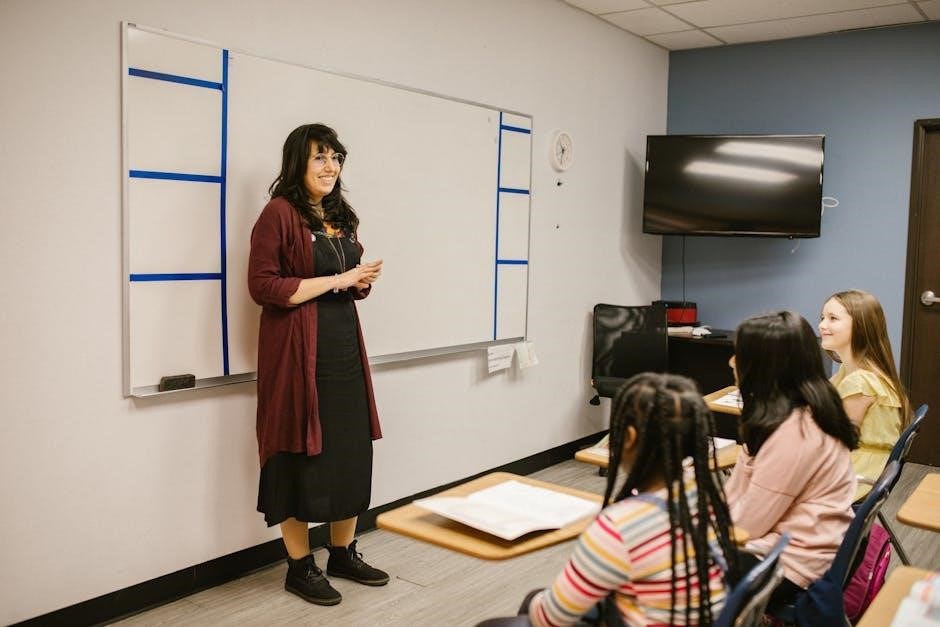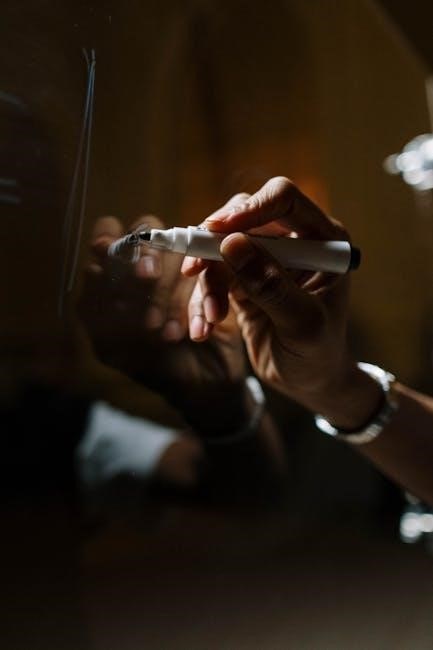Welcome to this comprehensive teaching manual designed for educators to enhance their instructional strategies. This guide focuses on developing essential skills such as online research, effective questioning, and critical thinking in students. It offers practical tools and resources to empower teachers in creating engaging and impactful learning experiences.

How to Teach Online Research Skills
Teach students to navigate digital spaces effectively by modeling search techniques, encouraging source evaluation, and fostering critical thinking. Use practical strategies to help students refine their online research abilities and find credible information efficiently.
2.1 Step-by-Step Approach to Teaching Online Research
Begin by introducing the basics of online research, such as understanding search engines and keywords. Guide students through defining their research topic and forming clear questions. Teach them to use advanced search filters to narrow results and evaluate sources for credibility. Encourage critical thinking by analyzing information quality and identifying biases. Provide hands-on practice with real-world examples, gradually increasing complexity. Offer feedback and support as students refine their skills. Incorporate collaborative activities to foster peer learning and discussion. Finally, reinforce ethical practices, such as proper citation and avoiding plagiarism. This structured approach ensures students develop robust online research skills essential for academic success.

2.2 Advanced Techniques for Effective Online Searching

To enhance students’ online research skills, introduce advanced techniques such as using Boolean operators (e.g., AND, OR, NOT) to refine search queries. Teach site-specific searches by limiting results to reputable domains like .edu or .gov. Demonstrate how to analyze URLs to determine credibility and identify biases. Encourage the use of tools like Google Scholar for academic sources and teach students to evaluate sources based on authority, relevance, and date. Introduce reverse image searches to verify authenticity and discuss the importance of avoiding echo chambers by exploring diverse perspectives. Additionally, guide students in using browser extensions or built-in tools to organize bookmarks and annotate web pages. These strategies help students become more efficient and discerning researchers, equipping them with lifelong skills for navigating the digital information landscape effectively.

Effective Questioning Strategies in the Classroom
Effective questioning fosters critical thinking and engagement by encouraging students to explore concepts deeply. Strategic use of open-ended and probing questions helps students connect ideas and develop a deeper understanding of the material.
3.1 The Importance of Asking Good Questions
Asking good questions is a cornerstone of effective teaching, fostering deeper understanding and critical thinking in students. It encourages active engagement, promoting a classroom environment where students explore ideas and concepts meaningfully. Good questions help students clarify their thoughts, make connections between ideas, and develop problem-solving skills. They also enable teachers to assess student comprehension, identify misconceptions, and tailor instruction to meet diverse learning needs. By fostering curiosity and inquiry, well-crafted questions inspire students to take ownership of their learning. This strategy not only enhances academic performance but also cultivates lifelong skills such as analytical thinking and effective communication. Incorporating thoughtful questioning into daily teaching practices ensures that students are challenged to think beyond surface-level understanding, preparing them for success in an increasingly complex world.
3.2 Using Questions to Engage Students and Promote Critical Thinking

Strategic questioning is a powerful tool to engage students and foster critical thinking. By posing thought-provoking questions, teachers can transform passive learning into active exploration. Open-ended questions encourage students to explore ideas from multiple perspectives, while targeted inquiries help them analyze and evaluate information. This approach not only deepens understanding but also prepares students to articulate their thoughts clearly. Teachers can use questions to stimulate peer discussions, debates, or reflective writing, creating a dynamic learning environment. Encouraging students to formulate their own questions further enhances their ability to think critically and solve problems. By integrating questioning into daily instruction, educators can inspire curiosity, creativity, and a growth mindset, empowering students to become independent learners. Effective questioning strategies ensure that students are not just absorbing information but actively constructing knowledge and meaning.

Best Practices for Using Questions as a Teaching Tool
Well-crafted questions stimulate critical thinking, encourage active participation, and promote deeper understanding. They should be clear, relevant, and challenging to inspire meaningful discussions and foster a collaborative learning environment.
4.1 Implementing Questions in Daily Teaching Practices
Integrating questions into daily teaching practices is essential for fostering engagement and critical thinking. Start by asking open-ended questions that encourage students to explore topics deeply. Use a mix of prepared and spontaneous questions to keep discussions dynamic. For example, begin lessons with thought-provoking inquiries to spark curiosity. Encourage students to formulate their own questions, promoting active learning. Additionally, incorporate wait time after asking questions to allow students to reflect and articulate their thoughts. Utilize visual aids like posters to remind students of effective questioning techniques. Consider implementing peer discussions where students can share and refine their questions. Regularly model how to ask clarifying and probing questions, demonstrating their value in understanding complex concepts. Over time, these practices will create a classroom culture where questioning becomes a natural part of the learning process, empowering students to think independently and critically.

Resources for Teachers
This section provides educators with essential tools and materials to enhance their teaching practices. Explore recommended eBooks, educational websites, and visual aids to support effective instruction and student engagement in various learning environments.

5.1 Recommended eBooks for Teaching Research Skills
Enhance your teaching practices with these highly recommended eBooks designed to foster effective research skills in students. Titles such as “Effective Online Research Skills” and “Teaching Students to Search Smart” offer practical strategies for guiding students in navigating digital information. Another valuable resource is “Research Skills for the Digital Age”, which provides tips on filtering information and avoiding misinformation. Additionally, “Engaging Students Through Questions” focuses on using inquiry-based learning to deepen critical thinking. These eBooks are packed with actionable advice, real-world examples, and innovative techniques to help educators create confident, independent learners. Whether you’re teaching elementary or high school students, these resources will equip you with the tools to make research skills a cornerstone of your curriculum. Explore these eBooks to refine your approach and empower your students with essential 21st-century skills.

5.2 Utilizing Posters and Visual Aids for Effective Learning
Visual aids like posters are powerful tools for creating engaging and interactive learning environments. They can help break down complex concepts into simple, digestible parts, making them ideal for teaching research skills. For instance, a poster on effective search techniques can serve as a constant reminder of key strategies for students. Similarly, infographics can visually guide students through the process of evaluating sources or avoiding misinformation. Teachers can also use whiteboard diagrams to illustrate how to structure a search query or organize findings. These visual tools not only enhance understanding but also promote active learning and critical thinking. By incorporating posters and other visual aids, educators can create a dynamic classroom experience that fosters independence and confidence in students’ research abilities. Examples of recommended posters include those on search techniques, source evaluation, and effective questioning, all of which align with the skills emphasized in this manual.
